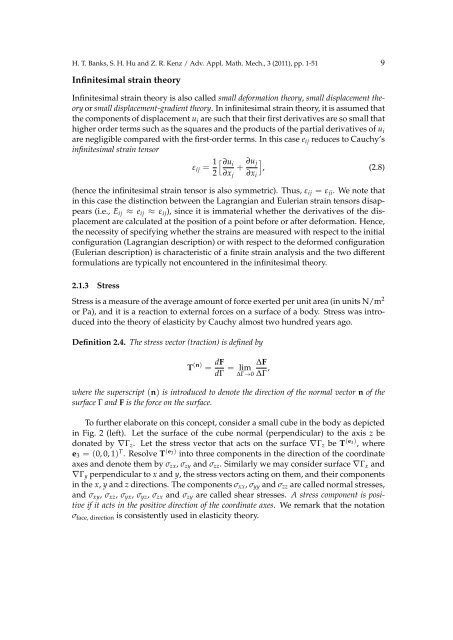A Brief Review of Elasticity and Viscoelasticity for Solids 1 Introduction
A Brief Review of Elasticity and Viscoelasticity for Solids 1 Introduction
A Brief Review of Elasticity and Viscoelasticity for Solids 1 Introduction
Create successful ePaper yourself
Turn your PDF publications into a flip-book with our unique Google optimized e-Paper software.
H. T. Banks, S. H. Hu <strong>and</strong> Z. R. Kenz / Adv. Appl. Math. Mech., 3 (2011), pp. 1-51 9<br />
Infinitesimal strain theory<br />
Infinitesimal strain theory is also called small de<strong>for</strong>mation theory, small displacement theory<br />
or small displacement-gradient theory. In infinitesimal strain theory, it is assumed that<br />
the components <strong>of</strong> displacement u i are such that their first derivatives are so small that<br />
higher order terms such as the squares <strong>and</strong> the products <strong>of</strong> the partial derivatives <strong>of</strong> u i<br />
are negligible compared with the first-order terms. In this case e ij reduces to Cauchy’s<br />
infinitesimal strain tensor<br />
ε ij = 1 [ ∂ui<br />
+ ∂u ]<br />
j<br />
, (2.8)<br />
2 ∂x j ∂x i<br />
(hence the infinitesimal strain tensor is also symmetric). Thus, ε ij = ε ji . We note that<br />
in this case the distinction between the Lagrangian <strong>and</strong> Eulerian strain tensors disappears<br />
(i.e., E ij ≈ e ij ≈ ε ij ), since it is immaterial whether the derivatives <strong>of</strong> the displacement<br />
are calculated at the position <strong>of</strong> a point be<strong>for</strong>e or after de<strong>for</strong>mation. Hence,<br />
the necessity <strong>of</strong> specifying whether the strains are measured with respect to the initial<br />
configuration (Lagrangian description) or with respect to the de<strong>for</strong>med configuration<br />
(Eulerian description) is characteristic <strong>of</strong> a finite strain analysis <strong>and</strong> the two different<br />
<strong>for</strong>mulations are typically not encountered in the infinitesimal theory.<br />
2.1.3 Stress<br />
Stress is a measure <strong>of</strong> the average amount <strong>of</strong> <strong>for</strong>ce exerted per unit area (in units N/m 2<br />
or Pa), <strong>and</strong> it is a reaction to external <strong>for</strong>ces on a surface <strong>of</strong> a body. Stress was introduced<br />
into the theory <strong>of</strong> elasticity by Cauchy almost two hundred years ago.<br />
Definition 2.4. The stress vector (traction) is defined by<br />
T (n) = dF<br />
dΓ = lim ∆F<br />
∆Γ→0 ∆Γ ,<br />
where the superscript (n) is introduced to denote the direction <strong>of</strong> the normal vector n <strong>of</strong> the<br />
surface Γ <strong>and</strong> F is the <strong>for</strong>ce on the surface.<br />
To further elaborate on this concept, consider a small cube in the body as depicted<br />
in Fig. 2 (left). Let the surface <strong>of</strong> the cube normal (perpendicular) to the axis z be<br />
donated by ∇Γ z . Let the stress vector that acts on the surface ∇Γ z be T (e 3) , where<br />
e 3 = (0, 0, 1) T . Resolve T (e 3) into three components in the direction <strong>of</strong> the coordinate<br />
axes <strong>and</strong> denote them by σ zx , σ zy <strong>and</strong> σ zz . Similarly we may consider surface ∇Γ x <strong>and</strong><br />
∇Γ y perpendicular to x <strong>and</strong> y, the stress vectors acting on them, <strong>and</strong> their components<br />
in the x, y <strong>and</strong> z directions. The components σ xx , σ yy <strong>and</strong> σ zz are called normal stresses,<br />
<strong>and</strong> σ xy , σ xz , σ yx , σ yz , σ zx <strong>and</strong> σ zy are called shear stresses. A stress component is positive<br />
if it acts in the positive direction <strong>of</strong> the coordinate axes. We remark that the notation<br />
σ face, direction is consistently used in elasticity theory.

















